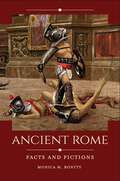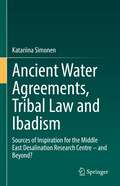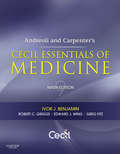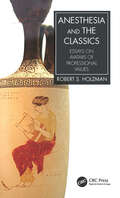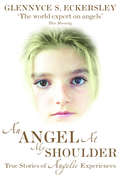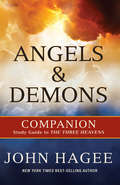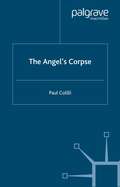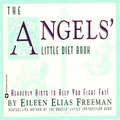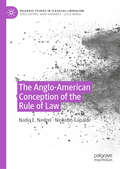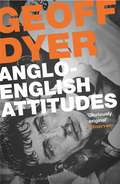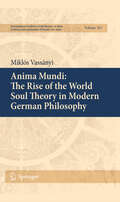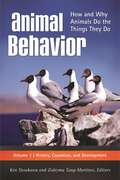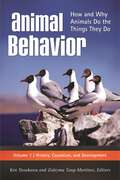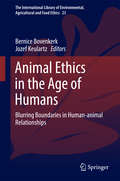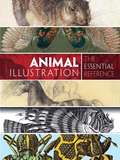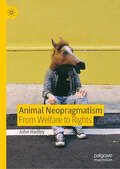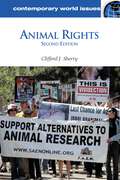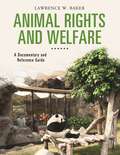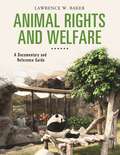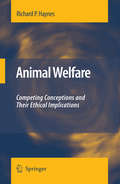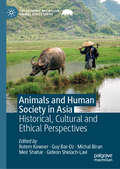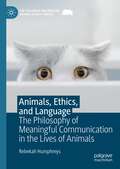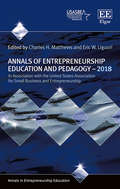- Table View
- List View
Ancient Rome: Facts and Fictions (Historical Facts and Fictions)
by Monica M. BonttyThis book shares little-known facts from and excerpts of primary source documents to correct popular misconceptions about Ancient Rome and to show how those misconceptions became widespread.Roman personalities and history have always had a larger-than-life profile in American popular culture, but most people think of this ancient civilization as merely decadent, cruel, and elitist. Most of our stereotypical conceptions of the empire and its people, however, are wrong. This book corrects popular misconceptions about the ancient Roman world, thus making ancient history relevant and accessible to modern readers and allowing modern critics of American politics and society to draw accurate comparisons.Each chapter discusses how a particular misconception developed, spread, and evolved into what we now believe to be the historical truth. Topics discussed include crucifixion, the destruction of Carthage, Julius Caesar's last words, and Roman hygiene. Excerpts from primary source documents provide evidence of both the rise of the historical fictions and the truths behind the myths.
Ancient Rome: Facts and Fictions (Historical Facts and Fictions)
by Monica M. BonttyThis book shares little-known facts from and excerpts of primary source documents to correct popular misconceptions about Ancient Rome and to show how those misconceptions became widespread.Roman personalities and history have always had a larger-than-life profile in American popular culture, but most people think of this ancient civilization as merely decadent, cruel, and elitist. Most of our stereotypical conceptions of the empire and its people, however, are wrong. This book corrects popular misconceptions about the ancient Roman world, thus making ancient history relevant and accessible to modern readers and allowing modern critics of American politics and society to draw accurate comparisons.Each chapter discusses how a particular misconception developed, spread, and evolved into what we now believe to be the historical truth. Topics discussed include crucifixion, the destruction of Carthage, Julius Caesar's last words, and Roman hygiene. Excerpts from primary source documents provide evidence of both the rise of the historical fictions and the truths behind the myths.
Ancient Water Agreements, Tribal Law and Ibadism: Sources of Inspiration for the Middle East Desalination Research Centre – and Beyond?
by Katariina SimonenThis book traces the development of Oman's inclusive agreements and highlights their importance for international negotiations, dealing with issues most relevant to humanity's own survival today, nuclear weapons or climate change.In Oman, a historical seafaring nation on the south-eastern corner of the Arabian Peninsula, a culture of agreement that accommodates the interests of everyone has developed around the division of scarce water resources.Life in the arid inland of the Omani Hajar mountains would not have been possible without water. Irrigation channel (falaj) construction is extremely old and skilful therein. Local practices evolved around the division of water and land on the basis of fairness. The community would be best served by inclusion and the avoidance of conflict.A specific Islamic school called Ibadi arrived at Oman early on in the eighth century. Ibadi scholars conserved local practices. Consultation and mediation by sheikhs and the religious leader, Imam, became the law of the land. The Omanis were known as the People of Consultation, Ahl Al Shura. In time, the practice of inclusive agreements would extend far beyond the village level, affecting Oman´s foreign policy under Sultan Qaboos. Oman´s water diplomacy succeeded in uniting the contestants of the Middle East Peace Process in the 1990s to work together on common problems of water desalination.
Andreoli and Carpenter's Cecil Essentials of Medicine E-Book: Andreoli And Carpenter's Cecil Essentials Of Medicine (Cecil Medicine)
by Ivor Benjamin Robert C. Griggs Thomas E. Andreoli J. Gregory FitzStudents, residents, and instructors swear by Andreoli and Carpenter’s Cecil Essentials of Medicine because it presents just the right amount of information, just the right way. Edited by the late Thomas E. Andreoli, MD as well as Ivor Benjamin, MD, Robert C. Griggs, MD, and Edward J. Wing, MD, it focuses on core principles and how they apply to patient care, covering everything you need to know to succeed on a medical rotation or residency. Masterful editing and a user-friendly full-color design make absorbing and retaining information as effortless as possible. New chapters on "Pre- and Post-Operative Care" and "Palliative Care," plus the integration of molecular biology and other new horizons in medicine, familiarize you with the most current clinical concepts. An expanded International Editorial Board provides increased input from respected practitioners worldwide. Excellent images and clinical photographs vividly illustrate the appearance and clinical features of disease. Masterful editing and a user-friendly full-color design make absorbing and retaining information as effortless as possible.
Anesthesia and the Classics: Essays on avatars of professional values
by Robert S. HolzmanA collection of 25 thought provoking Essays which create a bridge between the Classical personification of values and link them to current training and education in Western Medicine. This readable and erudite text provides a framework for modern clinical values - with a particular emphasis on anesthesiology - set in the context of ageless dilemmas facing each generation of physicians. Medicine as a profession carries some specific obligations.The qualities of empathy, knowledge, generosity, respect, and scholarship provide a "family" of values that was personified by the Ancients in the family of Asklepios, and which form the basis of professional values today. Moreover, a substantial amount of professional growth should come from reflection based on the experience of caring for real patients – an appreciation of the human condition. Each essay within this beautifully crafted book illustrates the importance of expertise, skill, focus, mindfulness, and collaboration, all of which are integral to professionalism in medicine, and in particular to those working in the field of anesthesiology. Anesthesiologists, Certified Registered Nurse Anesthetists and Anesthesia Assistants will find much to enhance their professional understanding within this text. The principles, values and traits of professionalism are relevant to all medical specialties and these essays provide a lyrical understanding of the traits required for professional development.
Anesthesia and the Classics: Essays on avatars of professional values
by Robert S. HolzmanA collection of 25 thought provoking Essays which create a bridge between the Classical personification of values and link them to current training and education in Western Medicine. This readable and erudite text provides a framework for modern clinical values - with a particular emphasis on anesthesiology - set in the context of ageless dilemmas facing each generation of physicians. Medicine as a profession carries some specific obligations.The qualities of empathy, knowledge, generosity, respect, and scholarship provide a "family" of values that was personified by the Ancients in the family of Asklepios, and which form the basis of professional values today. Moreover, a substantial amount of professional growth should come from reflection based on the experience of caring for real patients – an appreciation of the human condition. Each essay within this beautifully crafted book illustrates the importance of expertise, skill, focus, mindfulness, and collaboration, all of which are integral to professionalism in medicine, and in particular to those working in the field of anesthesiology. Anesthesiologists, Certified Registered Nurse Anesthetists and Anesthesia Assistants will find much to enhance their professional understanding within this text. The principles, values and traits of professionalism are relevant to all medical specialties and these essays provide a lyrical understanding of the traits required for professional development.
An Angel At My Shoulder: True Stories of Angelic Experiences
by Glennyce S. EckersleyThough angels have been part of our culture and our history for centuries, they have been forgotten in recent times, diminished to the level of christmas trinkets and the playthings of children. Until recently few would admit encountering angelic beings. Yet this extraordinary book shows angels are returning - and being acknowledged - once again. Here are true stories of countless ordinary people being rescued by angels, being comforted and healed by them, feeling their presence in the face of death and often appearing to little children. These tales are drawn from such countries as Britain, Australia, Ireland and the United States showing angels can be found all around the globe, helping people and often changing their lives completely. Full of warm and uplifting stories, An Angel At My Shoulder suggests it is more than time to reconsider our view of angels, to let them back into our hectic mechanized world and to realise we are never alone. . .
Angels and Demons: A Companion to The Three Heavens
by John HageeAn in-depth, interactive companion study to John Hagee's new bestseller, The Three Heavens.
The Angel’s Corpse (Semaphores and Signs)
by P. ColilliWith the great merit of Aristotle's Poetics , poetic logic became a theoretical activity endowed with a philosophical nature allowing it to be more philosophical than the pure representation of existence. Today, however, the theoretical status of poetic logic has been greatly demoted. The Angel's Corpse restores to poetic logic (or lyric philosophy) the cognitive and epistemological significance attributed to it by Aristotle. The Angel's corpse (the central metaphor in this restoration) is a sign-post beyond which there exists an uncharted terrain of human signification. This terrain is expressed in terms of lyric philosophy and its universal trait is a shocking into reawakening, which is linked to the dissolution of the repetitive logic of history. With this book, Colilli aims to bring to life the traits that are close to the Angel and which amount to a new philosophy of culture and interpretation. This philosophy is free from the ideological burden of previous systems, but pivots its cognito-epistemological premises on the idea of reawakening.
The Angels' Little Diet Book: Heavenly Hints to Help You Fight Fat!
by Eileen Elias FreemanThis collection of sage sayings will inspire you to lose weight by heeding the counsel of angels and the practical experience of the world's foremost angel watcher, a woman who has lost over 100 pounds herself.
The Anglo-American Conception of the Rule of Law (Palgrave Studies in Classical Liberalism)
by Nadia E. Nedzel Nicholas CapaldiThis book offers a multidisciplinary account of the 'rule of law' as a central pillar of the classical liberal tradition. The authors analyze the original meaning of this expression as first introduced by British jurist A. V. Dicey, before examining its subsequent elaboration by Leoni, Fuller, Hayek and Oakeshott. Addressing the main philosophical and legal aspects of the rule of law, this volume will appeal to all those engaged in law, political theory, philosophy, economics, business ethics, and public policy.
Anglo-English Attitudes
by Geoff DyerAnglo-English Attitudes brings together Geoff Dyer's best journalism and other writing from 1984-99. There are studied meditations on photographers (Robert Capa, William Gedney, Cartier-Bresson), painters (Bonnard, Gauguin), musicians (Coltrane, Nusrat Fateh Ali Khan), and close critical engagements with writers including Camus, Michael Ondaatje and Martin Amis. Also here are idiosyncratic reflections on boxing, comics, Airfix models and Action Man, and often hilarious accounts of his 'misadventures'.
Anima Mundi: The Rise of the World Soul Theory in Modern German Philosophy (International Archives of the History of Ideas Archives internationales d'histoire des idées #202)
by Miklós VassányiThis work presents and philosophically analyzes the early modern and modern history of the theory concerning the soul of the world, anima mundi. The initial question of the investigation is why there was a revival of this theory in the time of the early German Romanticism, whereas the concept of the anima mundi had been rejected in the earlier, classical period of European philosophy (early and mature Enlightenment). The presentation and analysis starts from the Leibnizian-Wolffian school, generally hostile to the theory, and covers classical eighteenth-century physico-theology, also reluctant to accept an anima mundi. Next, it discusses early modern and modern Christian philosophical Cabbala (Böhme and Ötinger), an intellectual tradition which to some extent tolerated the idea of a soul of the world. The philosophical relationship between Spinoza and Spinozism on the one hand, and the anima mundi theory on the other is also examined. An analysis of Giordano Bruno’s utilization of the concept anima del mondo is the last step before we give an account of how and why German Romanticism, especially Baader and Schelling asserted and applied the theory of the Weltseele. The purpose of the work is to prove that the philosophical insufficiency of a concept of God as an ens extramundanum instigated the Romantics to think an anima mundi that can act as a divine and quasi-infinite intermediary between God and Nature, as a locum tenens of God in physical reality.
Animal Behavior [3 volumes]: How and Why Animals Do the Things They Do [3 volumes]
by Alison M. Bell Andrew P. King Anna Dornhaus Anne Danielson-François Anthony C. Little Benedict C. Jones Bennett G. Galef Brett M. Gibson Brian Keane Bronwyn H. Bleakley Çağlar Akçay Carolynn L. Smith Catherine A. Marler Charles T. Snowdon Christopher D. Watkins Christopher Harshaw Christopher S. Evans David B. Mcdonald David Clark David Crews David F. Sherry David J. White Douglas W. Mock Geoffrey E. Hill George Uetz Guillermo Paz-Y-Miño-c James L. Gould Janis L. Dickinson Jason Low Jeffrey R. Alberts Ken Yasukawa Kenyon B. Mobley Laura Smale Lee Alan Dugatkin Lee C. Drickamer Lisa M. Debruine Mark E. Hauber Matthew J. Fuxjager Megan Hastings Hagenauer Meredith J. West Michael D. Beecher Michael J. Ryan Michelle Pellissier Scott Nancy G. Solomon Rachel A. Page Renée A. Duckworth S. Craig Roberts Sarah Jane Alger Sean P. Bradley Terry J. Ord Theodore Stankowich Walter D. Koenig Ximena E. Bernal Zenobia Lewis Zuleyma Tang-MartínezDiscover why animals do what they do, based on their genes, physiologies, cultures, traditions, survival and mating advantages, and evolutionary histories—and find out how studying behavior in the animal world helps us understand human behavior.The three volumes of Animal Behavior: How and Why Animals Do the Things They Do cover the breadth of the field, addressing causation, development, function, and evolution in a wide range of animals, from invertebrates to humans. Inspired by Nobel laureate Nikolaas Tinbergen's work, the first two volumes follow Tinbergen's four classic questions of animal behavior, while the third volume supplies integrated examples of Tinbergen's investigative process applied in specific cases.Written in an engaging, accessible manner ideal for college students as well as general audiences, this evidence-based collection provides a fascinating tour of animal behaviorists' findings, such as how animal communication can be truthful or deceitful, the deadly serious business behind clashes in the "battle of the sexes," and how documentation of animal behavior can lead to a deeper understanding of human behavior. Each chapter provides both historical background and information about current developments in animal behavior knowledge.
Animal Behavior [3 volumes]: How and Why Animals Do the Things They Do [3 volumes]
Discover why animals do what they do, based on their genes, physiologies, cultures, traditions, survival and mating advantages, and evolutionary histories—and find out how studying behavior in the animal world helps us understand human behavior.The three volumes of Animal Behavior: How and Why Animals Do the Things They Do cover the breadth of the field, addressing causation, development, function, and evolution in a wide range of animals, from invertebrates to humans. Inspired by Nobel laureate Nikolaas Tinbergen's work, the first two volumes follow Tinbergen's four classic questions of animal behavior, while the third volume supplies integrated examples of Tinbergen's investigative process applied in specific cases.Written in an engaging, accessible manner ideal for college students as well as general audiences, this evidence-based collection provides a fascinating tour of animal behaviorists' findings, such as how animal communication can be truthful or deceitful, the deadly serious business behind clashes in the "battle of the sexes," and how documentation of animal behavior can lead to a deeper understanding of human behavior. Each chapter provides both historical background and information about current developments in animal behavior knowledge.
Animal Ethics in the Age of Humans: Blurring boundaries in human-animal relationships (The International Library of Environmental, Agricultural and Food Ethics #23)
by Bernice Bovenkerk Jozef KeulartzThis book provides reflection on the increasingly blurry boundaries that characterize the human-animal relationship. In the Anthropocene humans and animals have come closer together and this asks for rethinking old divisions. Firstly, new scientific insights and technological advances lead to a blurring of the boundaries between animals and humans. Secondly, our increasing influence on nature leads to a rethinking of the old distinction between individual animal ethics and collectivist environmental ethics. Thirdly, ongoing urbanization and destruction of animal habitats leads to a blurring between the categories of wild and domesticated animals. Finally, globalization and global climate change have led to the fragmentation of natural habitats, blurring the old distinction between in situ and ex situ conservation. In this book, researchers at the cutting edge of their fields systematically examine the broad field of human-animal relations, dealing with wild, liminal, and domestic animals, with conservation, and zoos, and with technologies such as biomimicry. This book is timely in that it explores the new directions in which our thinking about the human-animal relationship are developing. While the target audience primarily consists of animal studies scholars, coming from a wide range of disciplines including philosophy, sociology, psychology, ethology, literature, and film studies, many of the topics that are discussed have relevance beyond a purely theoretical one; as such the book also aims to inspire for example biologists, conservationists, and zoo keepers to reflect on their relationship with animals.
Animal Illustration: The Essential Reference
by Carol Belanger GraftonComprehensive and entertaining, this volume comprises the greatest works in animal illustration from the Middle Ages through the twentieth century. The chronological presentation of hundreds of black-and-white and color images begins with a medieval illuminated manuscript by the Limbourg brothers and the Renaissance works of Albrecht Dürer and other artists from the first centuries of printing. Subsequent illustrations include the seventeenth-century real and imaginary animals of Matthäus Merian and the unique eighteenth-century compilations of Albertus Seba. Nineteenth-century images are drawn from sources as diverse as J. G. Heck's Bilder Atlas; the prints of Georges Baron Cuvier; William Jardine's 40-volume Naturalist's Library; bird illustrations by John James Audubon, Alexander Wilson, Edward Lear, and many others; extraordinary butterfly and insect images by E. A. Seguy, as well as animal illustrations from Victorian chromolithograph die cuts. The exquisite Edwardian bestiary of the Detmold brothers brings the collection into the twentieth century, and ends with the imagery of contemporary dinosaur artist James Gurney.Detailed bibliographical information concerning every source—including biographical details of each artist—makes this collection a vital reference tool as well as a splendid resource of outstanding animal illustrations. Students of graphic art and illustration, as well as graphic designers and advertising professionals, will prize this treasury of material from many rare historic sources.
Animal Neopragmatism: From Welfare to Rights
by John HadleyThis book affords a neopragmatic theory of animal ethics, taking its lead from American Pragmatism to place language at the centre of philosophical analysis. Following a method traceable to Dewey, Wittgenstein and Rorty, Hadley argues that many enduring puzzles about human interactions with animals can be ‘dissolved’ by understanding why people use terms like dignity, respect, naturalness, and inherent value. Hadley shifts the debate about animal welfare and rights from its current focus upon contentious claims about value and animal mindedness, to the vocabulary people use to express their concern for the suffering and lives of animals. With its emphasis on public concern for animals, animal neopragmatism is a uniquely progressive and democratic theory of animal ethics.
Animal Rights: A Reference Handbook (Contemporary World Issues)
by Clifford J. SherryThis revised edition helps readers understand and develop their own opinions on the fundamental issues, enduring controversies, and critical developments associated with animal rights.First published in 1994, Animal Rights: A Reference Handbook was widely acclaimed for its objective look at the ways in which humans treat animals. Extensively revised and updated, this new edition explores the basis for current perspectives on animal rights by addressing the relationship between humans and animals from scientific, philosophical, legal, and religious points of view.Animal Rights: A Reference Handbook, Second Edition maintains the balance and accessibility of the first edition, letting readers decide the bounds of human responsibility toward animals. It surveys a wide range of controversies surrounding the use of animals in such fields as the food industry, medical research, and the realm of entertainment, as well as the tremendous surge in scientific discoveries and technological advances that have led to new conversations on animal rights in the 21st century.
Animal Rights and Welfare: A Documentary and Reference Guide (Documentary and Reference Guides)
by Lawrence W. BakerThrough the use of primary source documents, readers can learn about key opinions and legislation in the important field of animal rights and welfare—a current and highly relevant topic.Animal Rights and Welfare: A Documentary and Reference Guide addresses a broad range of key topics within the subject of animal rights and welfare, including zoos, animal testing, philosophy regarding the treatment of animals, and practical measures instituted to protect animals, supplying readers with an impartial and authoritative resource for understanding the history of animal rights and the issues that dominate discussions about animal rights. Organized chronologically, the book discusses topics such as animal rights within the context of hunting for food, pelts, and other body parts, as well as for recreation; working animals; animals used for education or scientific and medical research; animals in the fashion and entertainment industries; and the food industry.The text provides reproductions of dozens of carefully selected primary documents from the time of Aristotle (B.C.) to present day to engage readers and provide opportunities for them to apply their critical thinking and analysis skills. The text of each document is introduced by a headnote to place it in context and concludes with analysis that details its significance and clarifies specific passages when needed. Each document or excerpt is followed by a full citation of the document.
Animal Rights and Welfare: A Documentary and Reference Guide (Documentary and Reference Guides)
by Lawrence W. BakerThrough the use of primary source documents, readers can learn about key opinions and legislation in the important field of animal rights and welfare—a current and highly relevant topic.Animal Rights and Welfare: A Documentary and Reference Guide addresses a broad range of key topics within the subject of animal rights and welfare, including zoos, animal testing, philosophy regarding the treatment of animals, and practical measures instituted to protect animals, supplying readers with an impartial and authoritative resource for understanding the history of animal rights and the issues that dominate discussions about animal rights. Organized chronologically, the book discusses topics such as animal rights within the context of hunting for food, pelts, and other body parts, as well as for recreation; working animals; animals used for education or scientific and medical research; animals in the fashion and entertainment industries; and the food industry.The text provides reproductions of dozens of carefully selected primary documents from the time of Aristotle (B.C.) to present day to engage readers and provide opportunities for them to apply their critical thinking and analysis skills. The text of each document is introduced by a headnote to place it in context and concludes with analysis that details its significance and clarifies specific passages when needed. Each document or excerpt is followed by a full citation of the document.
Animal Welfare: Competing Conceptions And Their Ethical Implications
by Richard P. HaynesMembers of the “animal welfare science community”, which includes both scientists and philosophers, have illegitimately appropriated the concept of animal welfare by claiming to have given a scientific account of it that is more objectively valid than the more “sentimental” account given by animal liberationists. This strategy has been used to argue for merely limited reform in the use of animals. This strategy was initially employed as a way of “sympathetically” responding to the abolitionist claims of anti-vivisectionists, who objected to the use of animals in research. It was subsequently used by farm animal scientists. The primarily reformist (as opposed to abolitionist) goals of this community make the false assumption that there are conditions under which animals may be raised and slaughtered for food or used as models in scientific research that are ethically acceptable. The tendency of the animal welfare science community is to accept this assumption as their framework of inquiry, and thus to discount certain practices as harmful to the interests of the animals that they affect. For example, animal welfare is conceptualized is such a way that death does not count as harmful to the interests of animal, nor prolonged life a benefit.
Animals and Human Society in Asia: Historical, Cultural and Ethical Perspectives (The Palgrave Macmillan Animal Ethics Series)
by Rotem Kowner Michal Biran Gideon Shelach-Lavi Meir Shahar Guy Bar-OzThis edited collection offers a comprehensive overview of the different aspects of human-animal interactions in Asia throughout history. With twelve thematically-arranged chapters, this book examines the diverse roles that beasts, livestock, and fish — real and metaphorical– have played in Asian history, society, and culture. Ranging from prehistory to the present day, the authors address a wealth of topics including the domestication of animals, dietary practices and sacrifice, hunting, the use of animals in war, and the representation of animals in literature and art. Providing a unique perspective on human interaction with the environment, the volume is cross-disciplinary in its reach, offering enriching insights to the fields of animal ethics, Asian studies, world history and more.
Animals, Ethics, and Language: The Philosophy of Meaningful Communication in the Lives of Animals (The Palgrave Macmillan Animal Ethics Series)
by Rebekah HumphreysWith an ever-growing body of evidence on the links between different oppressions, never have the debates in Critical Animal Studies surrounding intersectionality in relation to animal ethics been more important. In particular, the arguments related to anthropomorphic attributes of mentality to other than humans promise to provide fruitful new ground for re-assessing human-animal relations. This book maps the central debates surrounding anthropomorphism in relation to our descriptions of animals, their lives, animal mentality, and meaningful communication in the nonhuman world. Rebekah Humphreys synthesizes the work of critical animal theorists, philosophers, and cognitive ethologists, and provides a critical account of how the debates concerning anthropomorphism play a key role in a proper understanding of animal ethics.
Annals of Entrepreneurship Education and Pedagogy – 2018 (Annals in Entrepreneurship Education series)
by Charles H. Matthews Eric W. LiguoriIf you are looking for the intersection of past practices, current thinking, and future insights into the ever-expanding world of entrepreneurship education, then you will want to read and explore the third volume of the Annals of Entrepreneurship Education and Pedagogy. Prepared under the auspices of the United States Association for Small Business and Entrepreneurship (USASBE), this compendium covers a broad range of scholarly, practical, and thoughtful perspectives on a compelling range of entrepreneurship education issues. The third volume spans topics ranging from innovative practices in facilitating entrepreneurship teaching and learning inside and outside the classroom, learning innovation, model programs, to the latest research from top programs and thoughts leaders in Entrepreneurship. Moreover, the third volume builds on those previous as it continues to investigate critical issues in designing, implementing and assessing experiential learning techniques in the field of entrepreneurship. This updated volume provides insights and challenges in the development of entrepreneurship education for students, educators, mentors, community leaders, and more. Annals of Entrepreneurship Education and Pedagogy – 2018 is a must-have book for any entrepreneurship professor, scholar or program director dedicated to advancing entrepreneurship education in the US and around the world.
